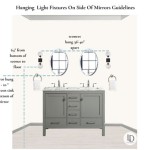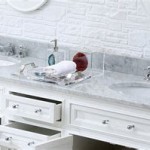Bathroom Sink and Cabinet: A Guide to Choosing the Right Combination
The bathroom sink and cabinet are integral components of any bathroom, impacting both functionality and aesthetics. Choosing the right combination involves careful consideration of various factors, including available space, budget, and desired style.
Bathroom sinks come in a variety of materials, each with its own pros and cons. Porcelain is a popular choice due to its durability, affordability, and ease of cleaning. Vitreous china, a type of porcelain with a higher density, offers even greater resistance to chipping and staining. Fireclay, made from molded clay fired at high temperatures, is known for its classic look and exceptional durability. Glass sinks add a touch of elegance and are available in a wide array of colors and textures, though they may require more diligent cleaning to prevent water spots. Composite sinks, made from a blend of materials such as resin and quartz, offer a variety of design options and are generally resistant to scratches and stains. Natural stone, like granite or marble, provides a luxurious aesthetic but requires regular sealing to prevent staining and damage.
Bathroom cabinets are typically constructed from wood, plywood, or medium-density fiberboard (MDF). Solid wood cabinets are known for their durability and timeless appeal, but they can be more expensive than other options. Plywood cabinets offer a good balance of strength and affordability. MDF cabinets are a cost-effective choice and offer a smooth surface for painting or laminating. The cabinet finish, whether paint, stain, or laminate, contributes to the overall style of the bathroom and should be chosen based on personal preference and the bathroom's existing decor.
Sink and cabinet combinations are available in various configurations. A pedestal sink, characterized by a single column supporting the basin, is a space-saving option suitable for smaller bathrooms. A wall-mounted sink, affixed directly to the wall, maximizes floor space and creates a modern, minimalist look. A console sink, featuring exposed legs and plumbing, adds a touch of vintage charm. The most common configuration is the vanity, which combines a sink with a cabinet, providing valuable storage space. Vanities are available in a wide range of sizes and styles, making them a versatile choice for most bathrooms.
When selecting a bathroom sink and cabinet, careful measurements are crucial. Consider the overall size of the bathroom and the available space for the vanity. Measure the width, depth, and height of the desired area to ensure the chosen combination fits comfortably. Additionally, consider the height of the sink and cabinet in relation to the users. Standard sink heights range from 30 to 36 inches, but taller or shorter individuals may require custom heights for optimal comfort.
Storage needs are another important factor to consider. Assess the amount of storage required for toiletries, towels, and other bathroom essentials. Vanities with drawers, shelves, or a combination of both offer versatile storage options. Consider the organization features within the cabinet, such as dividers or pull-out trays, to maximize storage efficiency.
Style preferences play a significant role in choosing the right combination. Bathroom sinks and cabinets are available in a wide range of styles, from traditional to contemporary. Consider the overall design aesthetic of the bathroom and choose a combination that complements the existing décor. Factors such as the shape of the sink, the style of the cabinet doors, and the hardware finishes contribute to the overall look and feel of the bathroom.
Budget is a practical consideration when selecting a bathroom sink and cabinet. Prices can vary significantly depending on the materials, size, and style. Establish a budget beforehand and explore options within that price range. Consider the long-term value and durability of the materials when making a decision. While a higher initial investment in quality materials may be more expensive upfront, it can result in cost savings in the long run due to reduced maintenance and replacement needs.
Installation requirements should be taken into account before purchasing a bathroom sink and cabinet. Some sinks and cabinets require professional installation, while others are designed for DIY installation. Assess your DIY skills and the complexity of the installation process. If professional installation is required, factor the cost of labor into the overall budget.
Plumbing considerations are essential when choosing a sink and cabinet. Ensure the chosen sink is compatible with the existing plumbing. Consider the location of the drain and the water supply lines. If modifications to the plumbing are required, consult a qualified plumber. Additionally, ensure the cabinet provides sufficient clearance for the plumbing fixtures.
Accessibility needs should be considered when designing a bathroom for individuals with mobility challenges. ADA-compliant sinks and cabinets are designed with specific dimensions and features to accommodate wheelchair users and individuals with limited mobility. Consider features such as lower sink heights, lever-style handles, and ample knee clearance beneath the sink.

Bathroom Vanities Thebath

Portola 65 Double Sink Vanity Pottery Barn

How To Choose The Perfect Bathroom Vanity Height Family Handyman

Bathroom Vanities The Home Depot

Walcut 36 Inch Bathroom Vanity With Sink Gray Vanities Modern Wood Cabinet Basin Vessel Set Mirror Chrome Faucet P Trap Com

Luxury Vanity Units Parker Howley Co Bespoke Furniture

Industrial Style Under Basin Wood Effect Bathroom Sink Cabinet Diy At B Q

Vanity Units Standing Or Wall Mounted Duravit

Bathroom Vanities Modern Bath Cabinets Crate Barrel
:strip_icc()/101117359-59dd243b83324c7aba23379dd8d46d0e.jpg?strip=all)
23 Gorgeous Bathroom Vanity Ideas To Fit Every Style







